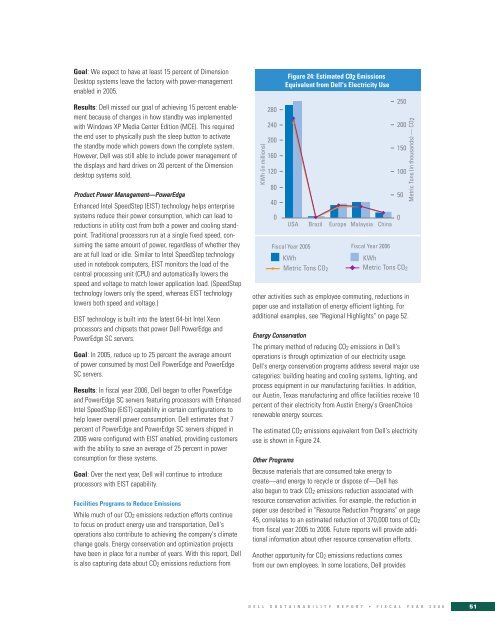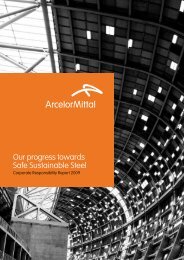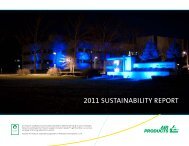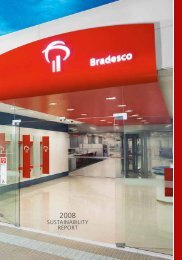Sustainability Report - Dell
Sustainability Report - Dell
Sustainability Report - Dell
Create successful ePaper yourself
Turn your PDF publications into a flip-book with our unique Google optimized e-Paper software.
Goal: We expect to have at least 15 percent of DimensionDesktop systems leave the factory with power-managementenabled in 2005.Results: <strong>Dell</strong> missed our goal of achieving 15 percent enablementbecause of changes in how standby was implementedwith Windows XP Media Center Edition (MCE). This requiredthe end user to physically push the sleep button to activatethe standby mode which powers down the complete system.However, <strong>Dell</strong> was still able to include power management ofthe displays and hard drives on 20 percent of the Dimensiondesktop systems sold.Product Power Management—PowerEdgeEnhanced Intel SpeedStep (EIST) technology helps enterprisesystems reduce their power consumption, which can lead toreductions in utility cost from both a power and cooling standpoint.Traditional processors run at a single fixed speed, consumingthe same amount of power, regardless of whether theyare at full load or idle. Similar to Intel SpeedStep technologyused in notebook computers, EIST monitors the load of thecentral processing unit (CPU) and automatically lowers thespeed and voltage to match lower application load. (SpeedSteptechnology lowers only the speed, whereas EIST technologylowers both speed and voltage.)EIST technology is built into the latest 64-bit Intel Xeonprocessors and chipsets that power <strong>Dell</strong> PowerEdge andPowerEdge SC servers.Goal: In 2005, reduce up to 25 percent the average amountof power consumed by most <strong>Dell</strong> PowerEdge and PowerEdgeSC servers.Results: In fiscal year 2006, <strong>Dell</strong> began to offer PowerEdgeand PowerEdge SC servers featuring processors with EnhancedIntel SpeedStep (EIST) capability in certain configurations tohelp lower overall power consumption. <strong>Dell</strong> estimates that 7percent of PowerEdge and PowerEdge SC servers shipped in2006 were configured with EIST enabled, providing customerswith the ability to save an average of 25 percent in powerconsumption for these systems.Goal: Over the next year, <strong>Dell</strong> will continue to introduceprocessors with EIST capability.Facilities Programs to Reduce EmissionsWhile much of our CO 2 emissions reduction efforts continueto focus on product energy use and transportation, <strong>Dell</strong>'soperations also contribute to achieving the company's climatechange goals. Energy conservation and optimization projectshave been in place for a number of years. With this report, <strong>Dell</strong>is also capturing data about CO 2 emissions reductions fromKWh (in millions)28024020016012080400other activities such as employee commuting, reductions inpaper use and installation of energy efficient lighting. Foradditional examples, see "Regional Highlights" on page 52.Energy ConservationThe primary method of reducing CO 2 emissions in <strong>Dell</strong>'soperations is through optimization of our electricity usage.<strong>Dell</strong>'s energy conservation programs address several major usecategories: building heating and cooling systems, lighting, andprocess equipment in our manufacturing facilities. In addition,our Austin, Texas manufacturing and office facilities receive 10percent of their electricity from Austin Energy's GreenChoicerenewable energy sources.The estimated CO 2 emissions equivalent from <strong>Dell</strong>'s electricityuse is shown in Figure 24.Other ProgramsFigure 24: Estimated C02 EmissionsEquivalent from <strong>Dell</strong>'s Electricity UseUSA Brazil Europe Malaysia ChinaFiscal Year 2005KWhMetric Tons CO 2Fiscal Year 2006250200150100Because materials that are consumed take energy tocreate—and energy to recycle or dispose of—<strong>Dell</strong> hasalso begun to track CO 2 emissions reduction associated withresource conservation activities. For example, the reduction inpaper use described in "Resource Reduction Programs" on page45, correlates to an estimated reduction of 370,000 tons of CO 2from fiscal year 2005 to 2006. Future reports will provide additionalinformation about other resource conservation efforts.Another opportunity for CO 2 emissions reductions comesfrom our own employees. In some locations, <strong>Dell</strong> provides500KWhMetric Tons CO 2Metric Tons (in thousands) — CO2D E L L S U S T A I N A B I L I T Y R E P O R T • F I S C A L Y E A R 2 0 0 651
















